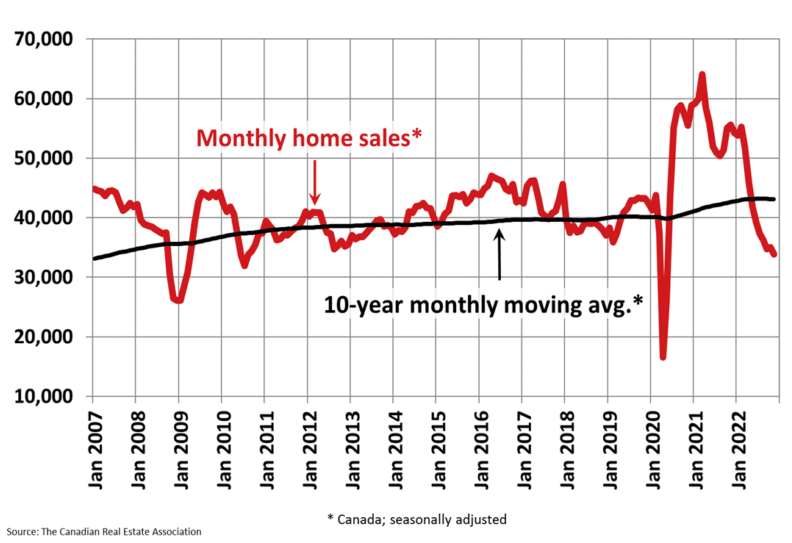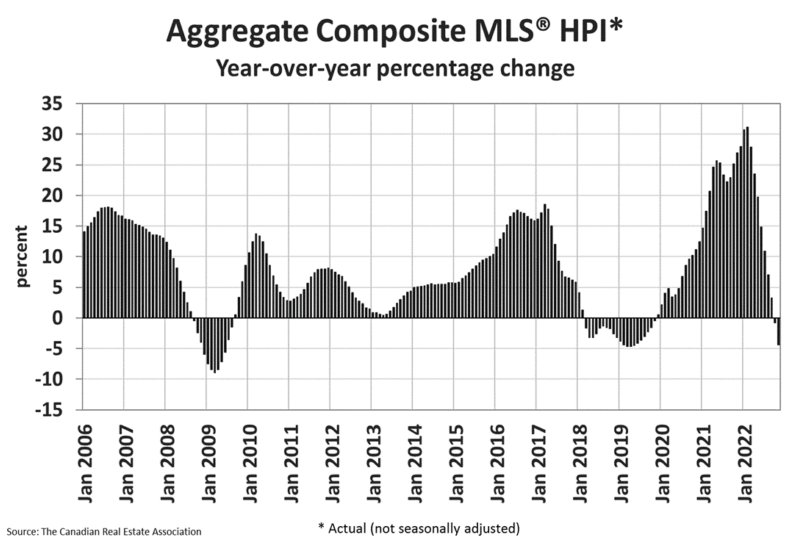Canadian home sales edge down from October to November
Ottawa, ON, December 15, 2022 – Statistics released today by the Canadian Real Estate Association (CREA) show national home sales were down on a month-over-month basis in November 2022.
Highlights:
- National home sales declined by 3.3% month-over-month in November.
- Actual (not seasonally adjusted) monthly activity came in 38.9% below November 2021.
- The number of newly listed properties edged down 1.3% month-over-month.
- The MLS® Home Price Index (HPI) declined by 1.4% month-over-month and was down 4.4% year-over-year.
- The actual (not seasonally adjusted) national average sale price posted a 12% year-over-year decline in November
Home sales recorded over Canadian MLS® Systems fell by 3.3% between October and November 2022, more than erasing October’s small gain and rejoining the moderating sales trend that began back in February.

About 60% of all local markets saw lower sales in November, led by Greater Vancouver and the Fraser Valley, Edmonton, the Greater Toronto Area (GTA) and Montreal.
The actual (not seasonally adjusted) number of transactions in November 2022 came in 38.9% below a near-record for that month last year and stood about 13% below the pre-COVID-19 10-year average for November sales.
“There were no big surprises in the November housing numbers, with the data showing the same trends of lower sales and moderating prices we’ve been seeing for a number of months now,” said Jill Oudil, Chair of CREA. “That said, while the interest rate situation facing buyers is unlikely to improve over the first half of 2023, it is more likely to remain the same. However, it may also be the first spring market in a number of years where buyers have a shot at not being out-competed for properties that catch their eye. If you’re thinking of buying or selling a property in 2023 make sure you get guidance and information early and contact a local REALTOR®,” continued Oudil.
“November’s housing data from across Canada came in as expected – still pretty quiet – and that is unlikely to improve this winter with the Bank of Canada raising rates again last week,” said Shaun Cathcart, CREA’s Senior Economist. “It will be interesting to see what buyers do when listings start to come out in big numbers in the spring, and even more interesting to see what happens a little later then the Bank of Canada, now widely thought to be at or very near the top of its tightening cycle, starts to eventually cut rates. All the other fundamental factors needed for the market to take off again are still out there.”
The number of newly listed homes edged down 1.3% on a month-over-month basis in November. New listings fell in slightly more than half of local markets. Among the larger markets in Canada month-over-month movements in new supply were generally small, the only exception being some larger declines in the B.C. Lower Mainland and Okanagan regions.
In terms of monthly new supply, the bigger picture is listings are not flooding the market. With the one exception of 2019, November 2022 saw the fewest new listings for that month in 17 years.
With sales down month-over-month by a little more than new listings in November, the sales-to-new listings ratio eased back to 49.9% compared to 50.9% in October. The ratio has remained close to around 50% since May. The long-term average for this measure is 55.1%.
Based on a comparison of sales-to-new listings ratio with long-term averages, about 70% of local markets are currently in balanced market territory.
There were 4.2 months of inventory on a national basis at the end of November 2022. This is close to where this measure was in the months leading up to the initial COVID-19 lockdowns, and still nearly a full month below its long-term average.
The Aggregate Composite MLS® Home Price Index (HPI) edged down 1.4% on a month-over-month basis in November 2022, continuing the trend that began back in the spring.
The Aggregate Composite MLS® HPI now sits about 11.5% below its peak level. Breaking that down regionally, the general trend is prices are down somewhat more than they are nationally in Ontario and parts of B.C., and down by less elsewhere. While prices have softened to some degree almost everywhere, Calgary, Regina and Saskatoon stand out as markets where home prices are barely off their peaks at all.
The non-seasonally adjusted Aggregate Composite MLS® HPI came in 4.4% below its November 2021 reading.

The actual (not seasonally adjusted) national average home price was $632,802 in November 2022, down 12% from the same month last year. The national average price is heavily influenced by sales in Greater Vancouver and the GTA, two of Canada’s most active and expensive housing markets. Excluding these two markets from the calculation cuts more than $123,000 from the national average price.
- 30 -
PLEASE NOTE: The information contained in this news release combines both major market and national sales information from MLS® Systems from the previous month.
CREA cautions that average price information can be useful in establishing trends over time, but does not indicate actual prices in centres comprised of widely divergent neighbourhoods or account for price differential between geographic areas. Statistical information contained in this report includes all housing types.
MLS® Systems are co-operative marketing systems used only by Canada’s real estate boards to ensure maximum exposure of properties listed for sale.
About The Canadian Real Estate Association
The Canadian Real Estate Association (CREA) is one of Canada’s largest single-industry associations, representing more than 155,000 REALTORS® working through 75 real estate boards and associations.
Further information can be found at http://crea.ca/statistics.
For more information, please contact:
Pierre Leduc, Media Relations
The Canadian Real Estate Association
Tel.: 613-237-7111 or 613-884-1460
E-mail: pleduc@crea.ca